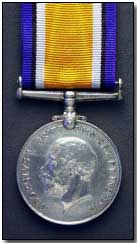Encyclopedia - British War Medal
 The British War Medal,
instituted on 29 July 1919, was awarded to men who had provided service
during and immediately after the First World War.
The British War Medal,
instituted on 29 July 1919, was awarded to men who had provided service
during and immediately after the First World War.
Initially intended to cover the period 1914-18 it was subsequently extended to those who had given additional service during 1919-20, typically in mine clearance and participation in operations in Russia, the Baltic, Siberia and the Black and Caspian Seas.
Royal Navy servicemen were required to have served for a period of at least 28 days before they were deemed eligible for the British War Medal (or to have lost their lives before then). Men who had enlisted with the O.M.F.C. but who had not seen action were not awarded the medal.
The 36mm medal was circular and made of silver. A bust of King George V featured on the obverse; St George on horseback was on the reverse of the medal, riding over the Prussian shield and skull and crossbones. The dates 1914 and 1918 also featured on the medal's reverse.
Although no additional Bar was made available, there were initial plans to permit such additional awards. Once it became clear however that both the army and navy intended to recommend sizeable numbers the idea was dropped.
In total some 5,670,170 BWMs were awarded, including 110,000 bronze medals awarded to Chinese, Indian and Maltese personnel who had served in labour battalions. Of the wider total approximately 600,000 BWMs were awarded to servicemen from Britain's colonies and dominions.
"Devil Dogs" was the nickname given to the U.S. Marines by the German Army.
- Did you know?
